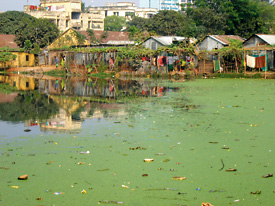A new U-M computer model of disease transmission in space and time can predict cholera outbreaks in Bangladesh up to 11 months in advance, providing an early warning system that could help public health officials there.
The new forecast model applies specifically to the capital city of Dhaka and incorporates data on both year-to-year climate variability and the spatial location of cholera cases at the district level. This allowed the researchers to study both local variation in disease transmission and response to climate factors within the megacity of 14 million people.

Life at the edge of a pond in one of the core districts of the city of Dhaka. The photograph illustrates some of the variation in living conditions and the problems with sanitary conditions that are greatly exacerbated later in the year with the floods of the monsoon season. Photo by Mercedes Pascual.
U-M theoretical ecologists Mercedes Pascual and Aaron King, along with former U-M postdoctoral researcher Robert Reiner and other colleagues, found evidence for a climate-sensitive urban core in Dhaka that acts to propagate cholera risk to the rest of the city. By including those findings in their model, the researchers were able to increase its accuracy and extend its forecasting ability far beyond previous disease models for the city.
Earlier models had prediction lead times of a month or less — too short to be of use in an early warning systems. The longer lead time of the new model will help inform decisions about treatment preparedness, vaccination and other disease-prevention strategies.
“What is new here is that we have analyzed the data in space and time by considering the cholera cases at the level of districts within the city,” says Pascual, the Rosemary Grant Collegiate Professor of Ecology and Evolutionary Biology. “Previous analyses here and in other places have aggregated the cases at the level of the whole city.
“This enables us to provide early warnings that are useful because they can help hospitals prepare for the effective treatment of large numbers of people,” she says.
The research team’s latest findings were published online last week in the Proceedings of the National Academy of Sciences.
In research done over the past decade, Pascual and her colleagues have found evidence that a phenomenon known as the El Niño-Southern Oscillation, a major source of climate variability from year to year, influences cycles of cholera in Bangladesh. Outbreaks increase after warm ENSO events and decrease following cold ENSO episodes.
The team also showed that the coupling between ENSO climate variability and cholera outbreaks has become stronger in recent decades, compared to the first part of the 20th century.
Cholera, a serious health problem in many parts of the world, results from a bacterial infection. The bacterium takes up residence in the intestines, causing vomiting and diarrhea, which can lead to severe dehydration and death if patients are not promptly treated.
Sanitary conditions and access to clean water are the main determinants of disease risk for cholera and other fecal-oral diseases. Those risk factors, in turn, are linked to the intensity of annual monsoon flooding, which greatly varies from place to place in Dhaka.
Pascual says she is working with Bangladesh researchers to implement the new warning system in Dhaka.
Low-lying Bangladesh widely is recognized as one of the countries most vulnerable to climate change. Natural hazards that come from increased rainfall, rising sea levels and tropical cyclones are expected to increase as the climate changes. At the same time, Dhaka’s population is expected to double over the next 25 years.

